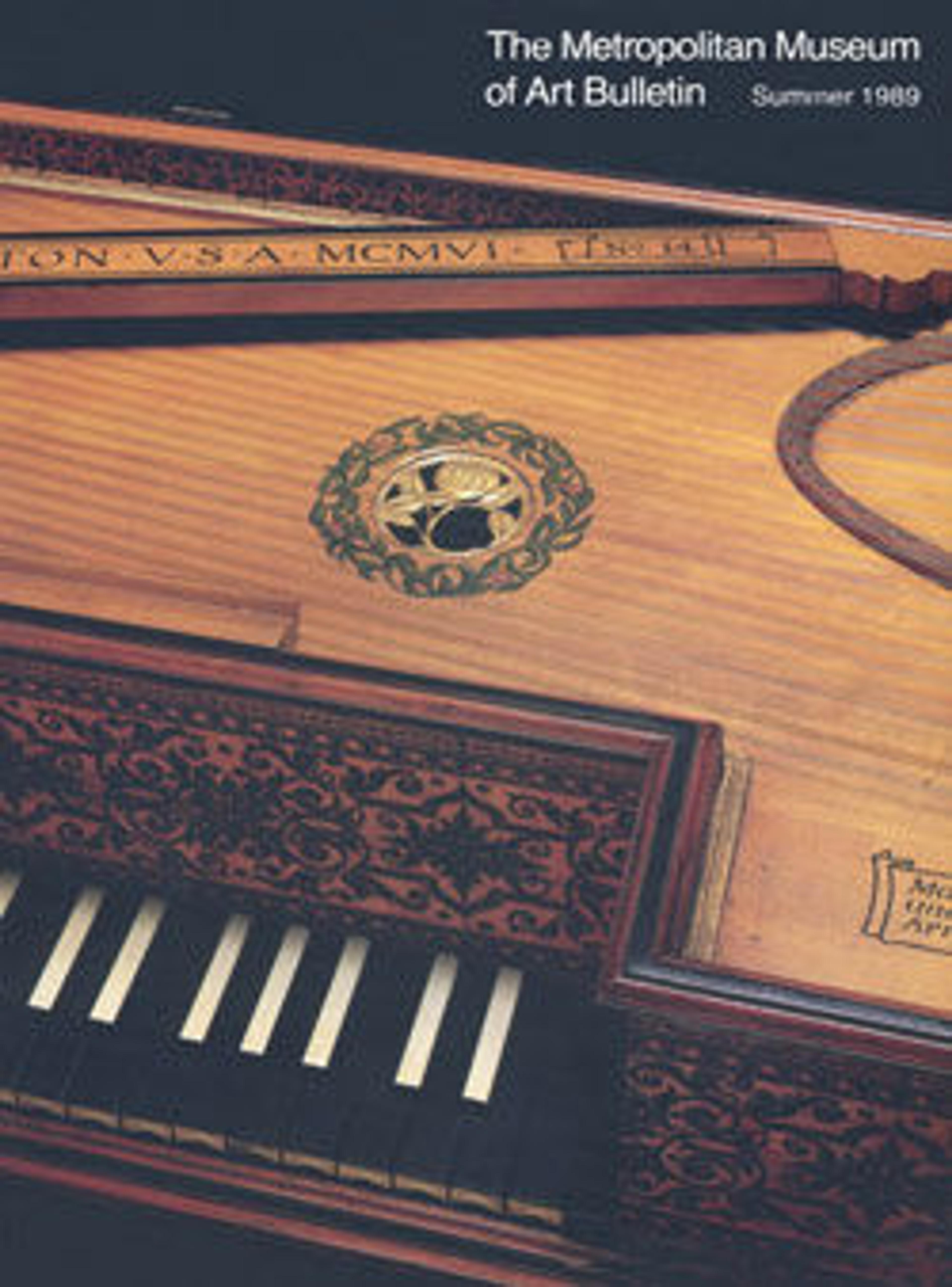Virginal
Arnold Dolmetsch is regarded as an important figure in the early movement for historically informed performance practice. Born in France, Dolmetsch studied music in Brussels and then in London. He exhibited a harpsichord at London's Arts and Crafts Exhibition of 1896. He accepted a position with Chickering & Sons piano company in Boston where he worked from 1904 until 1911 supervising the building period instruments including harpsichords, clavichords, lutes, and viols.
The Museum's virginal was built at the Chickering factory and is based on historic Flemish models. It is a double strung instrument with a compass of 4-1/2 octaves. The exterior of its case is a plain rectangular wooden case that has been painted black with imitation crackle effect. The stand includes a stretcher connecting the four outside legs. The front of the case and inside the key well and back wall are decorated with oiled, varnished paper painted in black with scrollwork design. Ebony natural topped keys with gilded wood fonts. Ivory topped accidental keys.
Technical description: Reconstruction of early Flemish original; double strung; compass 4-1/2 octaves C to F; plain rectangular wooden case (a) painted black, with imitation crackle effect; set into stand (b) by wooden pegs; stand of wood, painted black; on eight turned legs; four outside legs connected by lengthwise stretcher; front of case and inside rim covered with oiled, varnished paper painted in black with design of scrollwork, with egg and dart borders; inside of lid painted greenish-black with imitation crackle effect; three long shaped brass hinges connecting lid to case; soundhole, pierced, carved, and gilded circular medallion with rose, encircled by painted border of green leaves interspersed with five red buds, all outlined in black ivory sharps; ebony naturals, fronts of which faced with gilded wood; plain hinged wooden music rest, also acts as support for lid when open, key (c) of steel with ivory handle. (W. Winternitz 1984)
The Museum's virginal was built at the Chickering factory and is based on historic Flemish models. It is a double strung instrument with a compass of 4-1/2 octaves. The exterior of its case is a plain rectangular wooden case that has been painted black with imitation crackle effect. The stand includes a stretcher connecting the four outside legs. The front of the case and inside the key well and back wall are decorated with oiled, varnished paper painted in black with scrollwork design. Ebony natural topped keys with gilded wood fonts. Ivory topped accidental keys.
Technical description: Reconstruction of early Flemish original; double strung; compass 4-1/2 octaves C to F; plain rectangular wooden case (a) painted black, with imitation crackle effect; set into stand (b) by wooden pegs; stand of wood, painted black; on eight turned legs; four outside legs connected by lengthwise stretcher; front of case and inside rim covered with oiled, varnished paper painted in black with design of scrollwork, with egg and dart borders; inside of lid painted greenish-black with imitation crackle effect; three long shaped brass hinges connecting lid to case; soundhole, pierced, carved, and gilded circular medallion with rose, encircled by painted border of green leaves interspersed with five red buds, all outlined in black ivory sharps; ebony naturals, fronts of which faced with gilded wood; plain hinged wooden music rest, also acts as support for lid when open, key (c) of steel with ivory handle. (W. Winternitz 1984)
Artwork Details
- Title: Virginal
- Designer: Arnold Dolmetsch (French, born Le Mans, France 1858–1940 Haslemere, Surrey, England) , Chickering & Sons
- Manufacturer: Chickering & Sons (American, Boston 1853–1983)
- Date: 1906
- Geography: Boston, Massachusetts, United States
- Culture: American
- Medium: Wood, brass, ebony, ivory
- Dimensions: H.: 88.9 cm (35 in.); L. 172.7 cm (68 in.); W. 49.5 cm (19-1/2 in.)
H: w/o stand 26 cm;
Depth of stand 48 cm; width approximately 137 cm; Height of stand 63 cm - Classification: Chordophone-Zither-plucked-harpsichord
- Credit Line: Gift of Mrs. John G. Ralston, 1960
- Object Number: 60.51a–c
- Curatorial Department: Musical Instruments
More Artwork
Research Resources
The Met provides unparalleled resources for research and welcomes an international community of students and scholars. The Met's Open Access API is where creators and researchers can connect to the The Met collection. Open Access data and public domain images are available for unrestricted commercial and noncommercial use without permission or fee.
To request images under copyright and other restrictions, please use this Image Request form.
Feedback
We continue to research and examine historical and cultural context for objects in The Met collection. If you have comments or questions about this object record, please contact us using the form below. The Museum looks forward to receiving your comments.
